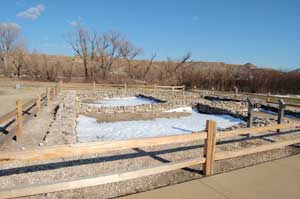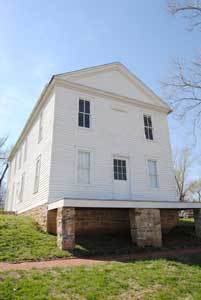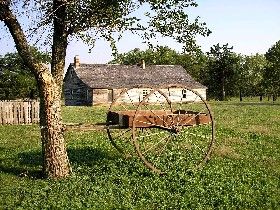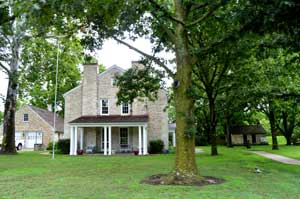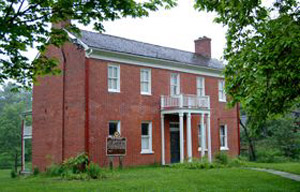With Kansas‘ history of Native American tribes, its role as a gateway to the West, its territorial struggles, and the Civil War, the state features several National & Kansas State Historic Sites.
National Historic Sites:
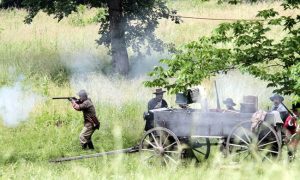
A re-creation of the Battle of Black Jack in which Pearson fought with John Brown. Photo courtesy Baldwin City Signal.
Black Jack Battlefield, Baldwin, Kansas – The three-hour Battle of Black Jack, fought on June 2, 1856, marked the culmination of escalating violence during the “Bleeding Kansas” era and the beginning of John Brown’s war on slavery, which would culminate in his raid on Harpers Ferry, West Virginia three years later.
Brown v. Board Of Education National Historic Site, Topeka, Kansas – Site of a landmark decision of the United States Supreme Court that declared state laws establishing separate public schools for black and white students unconstitutional.
California National Historic Trail, Northeast Kansas – Follow in the footsteps of over 250,000 emigrants who traveled to the goldfields and rich farmlands of California during the 1840s and 1850s — the greatest mass migration in American history.
Carrie Nation House, Medicine Lodge, Kansas – Home of temperance movement leader Carry A. Nation. She lived here from 1889 to 1902, and it was here that she began her crusade to shut down saloons. The building was declared a National Historic Landmark in 1976.
Council Grove Historic District, Council Grove, Kansas – In 1825, the United States and the Osage Nation negotiated a treaty that guaranteed safe passage through Osage territory to caravans on the Santa Fe Trail. It later became a natural stopping place on the trail, providing water, feed, and timber.
El Quartelejo, Scott County, Kansas – This archeological district consists of more than 20 sites, primarily associated with the Dismal River/Plains Apache culture, dating from about 1650 to 1750. The principal site is a pueblo ruin thought to have been built by Taos Indians seeking refuge with the Apache during times of trouble with the Spanish. It is the northeasternmost example of a pueblo in the country. The site also illustrates Spanish explorations in the Great Plains that predate those of the United States.
Fort Larned National Historic Site, Larned, Kansas – From 1860 until 1878, this was the most important fort guarding the northern portion of the Santa Fe Trail. Abandoned, the fort became private property and the center of a large ranching operation. It was restored in the 1860s to serve as one of the nation’s best-preserved mid-19th-century western military posts, consisting of one-story stone buildings arranged around a quadrangle.
Fort Leavenworth, Leavenworth, Kansas – This fort has been in continuous occupation by the United States Army since it was first established in 1827 to protect caravans on the Santa Fe Trail. It played a pivotal role in the Mexican-American and Civil Wars.
Fort Scott National Historic Site, Fort Scott, Kansas – This fort, established in 1842 and abandoned in 1853, served first as a frontier outpost along the “Permanent Indian Frontier,” then as a Civil War garrison. The fort was a major focal point of black troop activity and training during the Civil War.
Haskell Indian Nations University, Lawrence, Kansas – This is an accredited university for federally recognized Native American tribes; it was founded in 1884 as a residential boarding school for American Indian children. A self-guided walking tour map is available that features 12 campus buildings that are U.S. National Historic Landmarks.
Lewis & Clark National Historic Trail, northeast Kansas – Tracing the courses of the Missouri and Columbia Rivers, the Lewis and Clark National Historic Trail stretches through 11 states.
Medicine Lodge Peace Treaty Site – In October 1867, U.S. peace commissioners concluded treaties with the southern Plains tribes at this site that represent milestones in Government Indian relations.
Monument Rocks National Natural Landmark, Gove County, Kansas – The first natural landmark chosen by the US Department of the Interior as a National Natural Landmark.
Nicodemus National Historic Site, Nicodemus, Kansas – Former enslaved African Americans left Kentucky in organized colonies at the end of the post-Civil War Reconstruction period to experience freedom on the free soils of Kansas. Nicodemus represents the involvement of African Americans in the Westward Expansion and settlement of the Great Plains. It is the oldest and only remaining Black Town west of the Mississippi River.
Norman No. 1 Oil Well, Neodesha, Kansas – Abandoned oil well drilled on November 28, 1892, signifying the beginning of the development of the Mid-Continent oil field. Located at the Northeast corner of Mill and First Streets in Neodesha, Kansas. It was listed on the National Register of Historic Places in 1974 and declared a National Historic Landmark in 1977.
Oregon National Historic Trail, northeast Kansas – More than 2000 miles of trail ruts and traces can still be seen in six states along the Oregon National Historic Trail.
Parker Carousel, Abilene, Kansas – Also called the Lander Park Carousel or the Riverton Park Carousel, it is one of only three surviving carousels out of about 68 built by Abilene’s Charles W. Parker Carousel Company, and it is the only remains of the company in Abilene today. It was declared a National Historic Landmark in 1987.
Pony Express National Historic Trail, northeast Kansas – This relay system along the Pony Express National Historic Trail in eight states was the most direct and practical means of east-west communications before the telegraph.
Santa Fe National Historic Trail, across the entire width of Kansas – Follow the Santa Fe National Historic Trail through five states.
Santa Fe Trail Remains, Dodge City, Kansas – Also known as Santa Fe Trail Ruts, is a two-mile section of the former 1,200-mile-long Santa Fe Trail, the “longest continuous stretch of clearly defined Santa Fe Trail rut remains in Kansas.
Sumner Elementary School/Monroe Elementary School, Topeka, Kansas – The school was involved in the Supreme Court Case Brown v. Board of Education.
Tallgrass Prairie Reserve & Spring Hill Ranch, Strong City, Kansas – Tallgrass prairie once covered 170 million acres of North America. Within a generation, the vast majority was developed and plowed under. Today, less than 4% remains, mostly here in the Kansas Flint Hills.
Tobias-Thompson Complex, Geneseo, Kansas – The complex comprises a cluster of eight village sites along the Little Arkansas River dating from 1500 to 1700. These sites have been related to the Wichita Tribe and may have been among the villages visited by Coronado in Quivira in 1542.
Wagon Bed Spring, aka Lower Cimarron Spring, Ulysses, Kansas – An important watering spot on the Cimarron Cutoff of the Santa Fe Trail. It was declared a National Historic Landmark in 1961.
Warkentin Farm, Halstead, Kansas – Also known as Little River Stock Farm or Warkentin Farm, this 19th-century homestead became a notable site because of its historical significance in contributing to the history of local agriculture. It contains five buildings and an additional structure.
Western Branch, National Home for Disabled Volunteer Soldiers, Leavenworth, Kansas – The National Asylum for Disabled Volunteer Soldiers was established on March 3, 1865, in the United States by Congress to provide care for volunteer soldiers who had been disabled through loss of limb, wounds, disease, or injury during service in the Union forces in the Civil War.
Whiteford Price Site, Salina, Kansas – This prehistoric village and cemetery is representative of the Smoky Hill Culture, which dates to about 1000-1350. The unfortified village includes 12 to 15 known house sites, and the burial area contains the remains of more than 140 individuals. The site has been capped with concrete as a protective measure.
Wyandotte National Burying Ground, Kansas City, Kansas – This cemetery was established in about 1843, soon after the Wyandot Indians arrived following their removal from Ohio. The tribe settled in the area for years, with many in 1855 accepting allotment of lands in Kansas in severalty.
State Historic Sites:
Constitution Hall, Lecompton, Kansas* – The pro-slavery capitol of Kansas where the Bogus Legislature met.
Cottonwood Ranch, Studley, Kansas – An English-style home that was once a successful sheep ranch.
First Territorial Capitol, Fort Riley, Kansas – The first capitol of Kansas, it very briefly served the Bogus Legislature.
Fort Hays, Hays, Kansas – Frontier fort that once housed frontier names such as General George Armstrong Custer, William F. “Buffalo Bill Cody, and James B. “Wild Bill” Hickok.
Goodnow House, Manhattan, Kansas – Isaac Goodnow was a leader in the Free-State movement and founder of the college which became Kansas State University.
Grinter Place, Kansas City, Kansas – Moses Grinter traded with the Delaware Indians before building this brick farmhouse in 1862.
Hollenberg Pony Express Station, Hanover, Kansas* – 1858 Pony Express Station that also served as a stop along the Oregon–California Trail.
Iowa and Sac & Fox Mission – Highland, Kansas – Housed in an 1845 Presbyterian Mission, the Kansas State Historic Site features the historic emigration of the Great Lakes Indians who were forced into Kansas in the 1800s. It is located one mile north of U.S. 36 and two miles east of Highland, Kansas.
John Brown Museum, Osawatomie, Kansas – Reverend Samuel and Florella Adair struggled to survive on the Kansas frontier while sharing Abolitionist principles with Florella’s legendary half-brother, John Brown.
Kansas Museum of History, Topeka, Kansas – Award-winning museum featuring Kansas history from the earliest days, including Bleeding Kansas, Civil War, western trails, and the recent past.
Kansas State Capitol, Topeka, Kansas – This historic French Renaissance-style building is an impressive public monument and the working offices of the governor and legislators. A dramatic array of art, architecture, and colorful Kansas history can be found within these walls and on the 20-acre site.
Kaw Mission, Council Grove, Kansas – Historic stone mission on the Santa Fe Trail was once home to 50 Kanza Indian boys from 1851-1854.
Marais des Cygnes Massacre Site, Pleasanton, Kansas* – The nation was shocked when pro-slavery men gunned down 11 Free-State men in May 1858 in what is known as the Marais des Cygnes Massacre.
Mine Creek Battlefield, Pleasanton, Kansas* – One of the largest cavalry engagements of the Civil War was fought on this battlefield; the only major Civil War battle fought in Kansas.
Pawnee Indian Museum, Republic, Kansas – The museum encloses the excavated floor of one of the largest Pawnee Indian lodges.
Pawnee Rock, Pawnee Rock, Kansas – Popular landmark along the Santa Fe Trail.
Shawnee Indian Mission, Fairway, Kansas (Kansas City Metro area)* – An Indian school from 1839 to 1862, it also served briefly as the Kansas capitol.
State Archives & Library, Topeka, Kansas – Includes nearly every Kansas newspaper ever published, government archives, manuscript materials, 25,000 maps, and 500,000 photographs.
William Allen White House, Emporia, Kansas * – Home of Pulitzer-Prize-winning author and nationally known newspaperman William Allen White.
* Also a National Historic Site
Compiled and edited by Kathy Alexander/Legends of Kansas, updated February 2025.
Also See:


